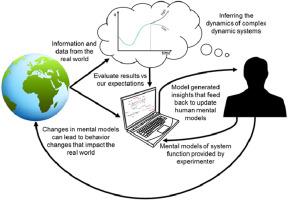当前位置:
X-MOL 学术
›
Ecol Modell
›
论文详情
Our official English website, www.x-mol.net, welcomes your feedback! (Note: you will need to create a separate account there.)
Model laboratories: A quick-start guide for design of simulation experiments for dynamic systems models
Ecological Modelling ( IF 3.1 ) Pub Date : 2020-10-01 , DOI: 10.1016/j.ecolmodel.2020.109246 Benjamin L. Turner
Ecological Modelling ( IF 3.1 ) Pub Date : 2020-10-01 , DOI: 10.1016/j.ecolmodel.2020.109246 Benjamin L. Turner

|
Abstract The use of dynamic systems models by scientists, managers, and policy-makers is becoming more common due to the increasingly complex nature of ecological and socio-economic problems. Unfortunately, most scientific training in the life sciences only includes dynamic modeling as elective, supplementary courses at a beginners-level, which is not conducive to generating the expertise needed to properly develop, test, and learn from dynamic modeling approaches and risks utilization of poor quality models and adoption of unreliable recommendations. The objective of this paper is to fill part of that gap, particularly regarding model experimentation, by summarizing key concepts in experimental design for simulation experiments and illustrating hands-on examples of experiments needed for developing a deeper understanding of complex, dynamic systems. The experiments include extreme conditions testing, sensitivity analyses of model behaviors given variation in both parameter values and graphical (table) functions, and “what-if?” experiments (e.g., counterfactual trajectories, boundary-adequacy tests, and intervention threshold experiments). Each experimental example describes the theoretical foundation of the test, illustrates its application using an ecological systems model, and increases in degree of difficulty from novice to advanced skill levels. By doing so, we demonstrate consistent, scientific means to glean valuable insights about the model's structure-behavior link, uncover any unforeseen model flaws or incorrect formulations, and enhance the confidence (validity) of the model for its intended use.
中文翻译:

模型实验室:动态系统模型仿真实验设计快速入门指南
摘要 由于生态和社会经济问题的性质日益复杂,科学家、管理者和决策者使用动态系统模型变得越来越普遍。不幸的是,生命科学领域的大多数科学培训只包括作为初学者级别的选修课和补充课程的动态建模,这不利于产生正确开发、测试和学习动态建模方法所需的专业知识,以及风险利用不佳的风险。质量模型和采用不可靠的建议。本文的目的是通过总结模拟实验的实验设计中的关键概念并说明深入理解复杂的实验所需的实践示例,来填补这一空白,特别是在模型实验方面。动态系统。实验包括极端条件测试、给定参数值和图形(表)函数变化的模型行为的敏感性分析,以及“假设?” 实验(例如,反事实轨迹、边界充分性测试和干预阈值实验)。每个实验示例都描述了测试的理论基础,使用生态系统模型说明了其应用,并从新手到高级技能水平增加了难度。通过这样做,我们展示了一致、科学的方法来收集有关模型结构-行为联系的宝贵见解,发现任何不可预见的模型缺陷或不正确的公式,并增强模型对其预期用途的信心(有效性)。给定参数值和图形(表)函数变化的模型行为的敏感性分析,以及“假设?” 实验(例如,反事实轨迹、边界充分性测试和干预阈值实验)。每个实验示例都描述了测试的理论基础,使用生态系统模型说明了其应用,并从新手到高级技能水平增加了难度。通过这样做,我们展示了一致、科学的方法来收集有关模型结构-行为联系的宝贵见解,发现任何不可预见的模型缺陷或不正确的公式,并增强模型对其预期用途的信心(有效性)。给定参数值和图形(表)函数变化的模型行为的敏感性分析,以及“假设?” 实验(例如,反事实轨迹、边界充分性测试和干预阈值实验)。每个实验示例都描述了测试的理论基础,使用生态系统模型说明了其应用,并从新手到高级技能水平增加了难度。通过这样做,我们展示了一致、科学的方法来收集有关模型结构-行为联系的宝贵见解,发现任何不可预见的模型缺陷或不正确的公式,并增强模型对其预期用途的信心(有效性)。反事实轨迹、边界充分性测试和干预阈值实验)。每个实验示例都描述了测试的理论基础,使用生态系统模型说明了其应用,并从新手到高级技能水平增加了难度。通过这样做,我们展示了一致的、科学的方法来收集有关模型结构-行为联系的宝贵见解,发现任何不可预见的模型缺陷或不正确的公式,并增强模型对其预期用途的信心(有效性)。反事实轨迹、边界充分性测试和干预阈值实验)。每个实验示例都描述了测试的理论基础,使用生态系统模型说明了其应用,并从新手到高级技能水平增加了难度。通过这样做,我们展示了一致、科学的方法来收集有关模型结构-行为联系的宝贵见解,发现任何不可预见的模型缺陷或不正确的公式,并增强模型对其预期用途的信心(有效性)。并从新手到高级技能水平的难度增加。通过这样做,我们展示了一致、科学的方法来收集有关模型结构-行为联系的宝贵见解,发现任何不可预见的模型缺陷或不正确的公式,并增强模型对其预期用途的信心(有效性)。并从新手到高级技能水平的难度增加。通过这样做,我们展示了一致的、科学的方法来收集有关模型结构-行为联系的宝贵见解,发现任何不可预见的模型缺陷或不正确的公式,并增强模型对其预期用途的信心(有效性)。
更新日期:2020-10-01
中文翻译:

模型实验室:动态系统模型仿真实验设计快速入门指南
摘要 由于生态和社会经济问题的性质日益复杂,科学家、管理者和决策者使用动态系统模型变得越来越普遍。不幸的是,生命科学领域的大多数科学培训只包括作为初学者级别的选修课和补充课程的动态建模,这不利于产生正确开发、测试和学习动态建模方法所需的专业知识,以及风险利用不佳的风险。质量模型和采用不可靠的建议。本文的目的是通过总结模拟实验的实验设计中的关键概念并说明深入理解复杂的实验所需的实践示例,来填补这一空白,特别是在模型实验方面。动态系统。实验包括极端条件测试、给定参数值和图形(表)函数变化的模型行为的敏感性分析,以及“假设?” 实验(例如,反事实轨迹、边界充分性测试和干预阈值实验)。每个实验示例都描述了测试的理论基础,使用生态系统模型说明了其应用,并从新手到高级技能水平增加了难度。通过这样做,我们展示了一致、科学的方法来收集有关模型结构-行为联系的宝贵见解,发现任何不可预见的模型缺陷或不正确的公式,并增强模型对其预期用途的信心(有效性)。给定参数值和图形(表)函数变化的模型行为的敏感性分析,以及“假设?” 实验(例如,反事实轨迹、边界充分性测试和干预阈值实验)。每个实验示例都描述了测试的理论基础,使用生态系统模型说明了其应用,并从新手到高级技能水平增加了难度。通过这样做,我们展示了一致、科学的方法来收集有关模型结构-行为联系的宝贵见解,发现任何不可预见的模型缺陷或不正确的公式,并增强模型对其预期用途的信心(有效性)。给定参数值和图形(表)函数变化的模型行为的敏感性分析,以及“假设?” 实验(例如,反事实轨迹、边界充分性测试和干预阈值实验)。每个实验示例都描述了测试的理论基础,使用生态系统模型说明了其应用,并从新手到高级技能水平增加了难度。通过这样做,我们展示了一致、科学的方法来收集有关模型结构-行为联系的宝贵见解,发现任何不可预见的模型缺陷或不正确的公式,并增强模型对其预期用途的信心(有效性)。反事实轨迹、边界充分性测试和干预阈值实验)。每个实验示例都描述了测试的理论基础,使用生态系统模型说明了其应用,并从新手到高级技能水平增加了难度。通过这样做,我们展示了一致的、科学的方法来收集有关模型结构-行为联系的宝贵见解,发现任何不可预见的模型缺陷或不正确的公式,并增强模型对其预期用途的信心(有效性)。反事实轨迹、边界充分性测试和干预阈值实验)。每个实验示例都描述了测试的理论基础,使用生态系统模型说明了其应用,并从新手到高级技能水平增加了难度。通过这样做,我们展示了一致、科学的方法来收集有关模型结构-行为联系的宝贵见解,发现任何不可预见的模型缺陷或不正确的公式,并增强模型对其预期用途的信心(有效性)。并从新手到高级技能水平的难度增加。通过这样做,我们展示了一致、科学的方法来收集有关模型结构-行为联系的宝贵见解,发现任何不可预见的模型缺陷或不正确的公式,并增强模型对其预期用途的信心(有效性)。并从新手到高级技能水平的难度增加。通过这样做,我们展示了一致的、科学的方法来收集有关模型结构-行为联系的宝贵见解,发现任何不可预见的模型缺陷或不正确的公式,并增强模型对其预期用途的信心(有效性)。



























 京公网安备 11010802027423号
京公网安备 11010802027423号